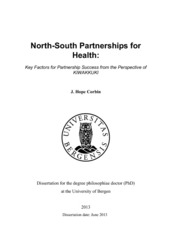| dc.description.abstract | Background: North-South Partnership (NSP) is a main strategy for health promotion work in Africa. Northern partners contribute funding and expertise and Southern partners contribute crucial knowledge of context and capacity for local action. This model is widely promoted within health promotion documents but actual practice is not well understood. In addition to being largely anecdotal, the literature on NSP is limited by the tendency to draw overly pessimistic conclusions, by comparing idealistic definitions of partnership to real-world examples. There is a failure in the literature to systematically examine NSP by criteria of partnership functioning generally. The few case studies that do exist focus primarily on power relations, characterizing NSP as one-way streets of accountability where Northern partners dictate the agenda and issue demands. As Southern organizations engage in NSP, those that are successful grow as a result. Some authors suggest that this process of scaling up can draw the organization’s focus toward global advocacy and professionalization, and away from their community empowerment work. However, these assumptions are mere speculation without case studies specifically examining these processes in practice. Another complicated interaction within NSP is the empowerment of and relationship to the local Southern community, often an important motivator for Northern partners to engage with Southern partners. Voluntary community members in these grassroots organizations represent tremendous partner resources, however, their motivations, roles and the impact of context on volunteer work is not sufficiently explored in the existing literature. Objective: The study used a systems model, the Bergen Model of Collaborative Functioning, to map NSP processes over the 18-year history of a Southern organization’s partnerships with Northern organizations, through scaling-up processes and interacting with grassroots volunteers. Design: A case study design was used. The case was purposely selected because of its reputation of success over many years of operation within many longstanding NSPs. The case, KIWAKKUKI, is a women’s grassroots organization working on issues of HIV and AIDS in the Kilimanjaro region of Tanzania. Documents, observations and, primarily, interview data were collected. Data collection occurred during two field visits in 2008 and 2009. Document data included formal reports, internal forms and records and email exchanges with Northern partners. Observational data was collected during both field trips and field logs were kept. In the first round of interviews in 2008, nine participants were interviewed. An additional 12 interviews were conducted in 2009, nine of which were new participants while three participants were interviewed a second time. The interviews were open-ended and lasted an average of one hour. The Bergen Model of Collaborative Functioning was employed to analyze the data. Themes were identified and coded using an iterative process several times during the research. An established framework for scaling up was also used to examine the experience of growth of KIWAKKUKI. Findings: Mapping KIWAKKUKI’s NSP experience demonstrated that even in effective partnerships, both positive and negative processes are present. It was also observed that KIWAKKUKI’s partnership breakdowns were not strictly negative, as they provided lessons that facilitated learning and improved future partnership work. KIWAKKUKI, a successful, experienced Southern organization with a grassroots base of over 6000 volunteers described a give and take of power in their NSP relationships. The success and synergy KIWAKKUKI experienced through its NSPs led to rapid growth in both its partnerships and grassroots base. The grassroots growth necessitated an increase in volunteer capacity-building that overextended the available funds for those activities. The result was that new volunteers were not trained as thoroughly as veteran volunteers and participants believed services suffered as a result. Northern partners’ mission was identified as being the key factor in determining if they would fund capacity building for grassroots volunteers. Examination of KIWAKKUKI’s relationship with grassroots volunteers tdemonstrated that the volunteers’ knowledge of local people and conditions was crucial to successful functioning within the organization. Volunteers were motivated by their desire to learn to care for family members, to reverse stigma, and to work with other women. Volunteers’ engagement was enhanced not just by work-related activities, but also by welcoming and supportive activities (sharing stories and singing together, for example). Volunteers were affected by their experience: positively, through empowerment, improving skills, and by community recognition; and negatively, by burnout, conferred stigma and in extreme cases, domestic violence. The Tanzanian context powerfully affected how and why volunteers engaged with KIWAKKUKI. Conclusions: The study highlights the importance of acknowledging and reporting on both positive and negative processes to maximise learning in North-South partnerships. This is demonstrated by the new insights illuminated by this research that too much synergy can be bad (growth outpacing capacity-building) and that antagony, or negative processes, can be good by facilitating opportunities to learn from mistakes. The need for capacity-building for volunteers is crucial and would benefit from clear statements of commitment and an agreed mission within individual NSPs to support, empower and train the volunteer base, as much of the value of NSPs is derived from this community contribution. Strengthening the grassroots base not only improves the services and the cultural appropriateness of health promotion work, the findings also indicate that Southern organizations strongly founded on a large grassroots volunteer base (partner resources) can balance the power afforded to Northern partners with their large financial contributions (financial resources). | en_US |
| dc.relation.haspart | Paper II: Corbin, J.H., Mittelmark, M.B. and Lie, G.T. (2012). Scaling-up and rooting-down: A case study of North-South partnerships for health from Tanzania. Glob Health Action, 5: 18369. The article is available in BORA: <a href="http://hdl.handle.net/1956/7446" target="blank"> http://hdl.handle.net/1956/7446</a> | eng |
